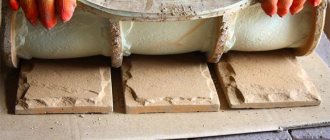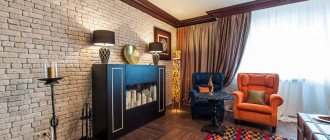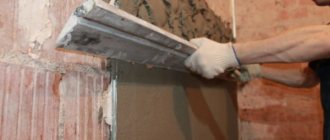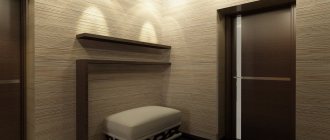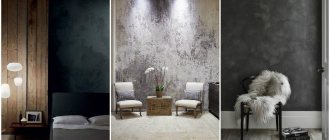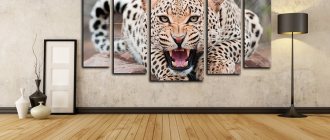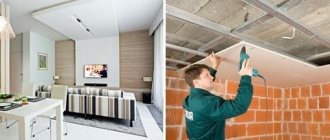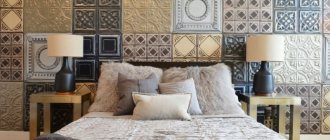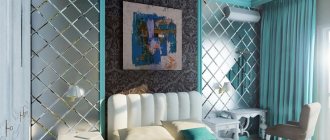Plaster in modern design
Gypsum is a natural mineral that has been used in construction for thousands of years. It is known that the ancient Egyptians already held together the blocks of the pyramids (including the pyramids of Cheops) with gypsum mortar. Later, gypsum began to be used for castings and impressions, making surfaces of any shape: ceiling cornices, bas-reliefs and other decorations.
Today, the use of gypsum has become more diverse. Natural material is mined in quarries, subjected to heat treatment and crushed into powder. Depending on the fineness of grinding, construction (alabaster) or molding gypsum is obtained; Medical gypsum is obtained from highly purified raw materials.
Beige brick in a classic living room Source pinwin.ru
In the design of premises, gypsum ceiling parts, cornices and chandelier sockets are widely used, but decorative gypsum tiles are the most widely used. It is used for finishing walls and ceilings and is called decorative artificial stone.
Tile decor is suitable for decorating any room, from the living room and office, to the kitchen and corridor. With its help, they create furniture elements, decorate fireplaces, niches and arches. The material is interesting because it is able to accurately convey the relief and texture of natural surfaces. Therefore, varieties that imitate stone and brick are especially successful.
Design of a doorway Source design-homes.ru
Various finishing materials
How to decorate a wide doorway? This question is often faced by those who decide to completely redo the doorway, getting rid of the wooden panel and frame.
Doorway finishing option
- decorative brick;
- various elements made of wood and MDF panels;
- PVC panels;
- fake diamond;
An example of finishing an opening with artificial stone
It is worth noting that the list of suitable materials indicated earlier in the text is not final; you can finish it in any style based on your taste; above we have indicated only the most common and available options today.
»
Advantages and disadvantages
The popularity of gypsum tiles for interior decoration is due to its following advantages:
- Light weight. Gypsum tiles are lighter than other finishing materials. This means that it minimally loads the base and can be used for cladding the thinnest partitions; When laying it, you do not need to use reinforcement.
- Availability. Gypsum is a common mineral in nature, relatively easy to process, so the tiles are cheap.
Ceiling plaster decor Source design-homes.ru
- Easy installation. The tiles can be laid on any surface and do not require adjustment; if necessary, it can be easily trimmed with a hacksaw or jigsaw. For masonry, glue or liquid nails are used.
- Environmentally friendly. The material is based on natural ingredients, so the tiles do not emit substances that affect human and animal health.
- Microclimate adjustment. Gypsum is a porous material, so it is able to absorb excess moisture and release it if the air in the room becomes dry.
- Performance characteristics. The tile has good soundproofing qualities, it is durable and fire-resistant.
Modern style bedroom interior Source hzcdn.com
- Design possibilities. A significant advantage of the material is its realistic surface texture and variety of colors and textures. On the market you can find products that imitate any type of stone and brick.
The main disadvantage of gypsum decorative tiles to look like stone or brick is their poor tolerance to moisture, temperature fluctuations and mechanical influences (a careless blow can cause a chip or crack). The surface lined with relief material is quite difficult to care for. To protect the decor from dust and dirt, it is coated with a layer of special varnish, which means additional expenses.
Wall design in the living room Source archilovers.com
Using PVC panels for subsequent finishing of doorways
To make the doorway look more original, use standard PVC plastic panels. This is due to the abundance of color shades of the material, as well as the ease of its use in any room, room or other space. Plastic panels can often even imitate the surface of stones, while their cost is several times cheaper.
PVC panels of different colors for finishing doorways
Let's look at the main advantages:
- Low cost compared to all other materials.
- Fairly simple care.
- Installation is carried out on your own without assistance.
- Huge selection of color shades and textures.
Most often, when using PVC panels, finishing is done with color sheets that have warm woody shades. The convenience of installing such finishing elements is that they can be easily attached to liquid nails, without resorting to the use of screws, nails and cement mortar, which greatly facilitates the installation procedure, which can be done independently without much difficulty.
Important. Mounting these elements at the front door is irrelevant, since unlike stone and wood, plastic is quite fragile and the slightest mechanical damage can lead to a crack.Features of the material
High-quality gypsum tiles are produced on modern production lines. During the process, temperature and humidity are constantly monitored, making the tile material light and durable.
The main component of the mixture is gypsum; it can differ in grinding fineness and color (from pure white to light gray). The quality of the gypsum affects the elaboration of the relief, as well as how contrasting the color of the surface will be. The mixture also includes sand and water.
Decorating slopes on a former balcony Source lakbermagazin.hu
See also: Catalog of companies that specialize in finishing materials and related work
The production process takes into account the natural properties of gypsum; To improve them, additional components - modifiers - are added to the mixture. Thanks to modifiers, after drying, the tile acquires additional strength and becomes more durable. Such cladding is less susceptible to chipping and crumbling during operation. The following additives are used for improvement:
- Plasticizers. They optimize the gypsum-water ratio; as a result, moisture absorption decreases and the strength of the material increases.
- Water repellents. By reducing water absorption, they give the products additional water-repellent properties.
- Fiber fiber. Polypropylene fiber is a reinforcing additive that increases the fracture and bending strength of products. As a result, the strength of the tile increases by 50%.
Decor with a volume effect Source modernplace.ru
Manufacturers offer decorative material in two versions: in the form of individual rectangular elements or in the form of blocks of several such elements. Blocks usually have a relief, well-developed surface; one block consists of several elements in the form of bricks or stones. The sizes of gypsum tile products vary widely:
- Tiles imitating brick. The length of the element is in the range of 19-28 cm, width - 6-10 cm.
- Stone imitation tiles. Length is 21-37 cm, width – 9-10 cm.
- Corner elements have a side edge length of 7-12 cm.
Blocks with geometric patterns Source pinimg.com
Laying technology
Tool
- Spatulas: regular and serrated;
- Level;
- Hacksaw or grinder;
- Miter box;
- Drill mixer;
- Foam sponges;
- Grouting spatula;
- A construction gun or a milk carton;
- A pair of brushes;
- Sandpaper and whetstone;
Materials
Installation with gypsum glue.
- Glue. You can use any tile or gypsum material, for example “Knauf Perlfix” or “VOLMA MONTAGE”. Can also be laid on liquid nails. Some have glue included.
- Water based varnish.
- Dyes for grout and tiles;
- Primer.
- Grout for seams.
Step 1: Marking
The technology for laying gypsum tiles, including markings, is similar to the technology for laying ceramic tiles. It is important to find the starting points, horizontal and vertical, based on considerations of smooth, accurate cladding and geometric aesthetics. Typically, decorative tiles begin to be laid from the corners, so the markings are tied to them.
Decorative stone-look tiles are often of different formats, so take this point into account so that there are no duplicates one after another. Gypsum brick tiles are simpler in this regard; if necessary, you can immediately mark the location of any element.
Mark each row to avoid cutting at the top and bottom. At the bottom of the wall, a groove was made in the plaster so that the laminate would go there for a beautiful connection.
Step 2: Styling
To mix the glue, use a drill with a mixing attachment. The consistency of the composition should resemble thick sour cream. Apply the mixture with a spatula to a base that has been previously primed to enhance the surface and adhesion. To level the layer of glue, the residues are removed with a notched spatula - a comb. Next, lay the tiles, pressing them tightly to the base.
Applying glue with a spatula-comb.
Step 3: Trimming
Since gypsum is a soft material, it can be cut with a hacksaw. For convenience, they use an angle grinder, but it creates too much noise and dust. It is important to join the outer corners correctly. To make them look beautiful, the tiles are cut at an angle of 45 degrees. This is where a miter box comes in handy. Some areas may require additional treatment. In this case, the tiles are ground with a block and brought to condition with sandpaper.
Arches and similar places require figure cutting. In the case of tiles with torn edges, it is easiest to cut along the textured line. If you use an angle grinder, you can ignore this.
Step 4: Grouting
As a putty for joints, either a special grout mixture is used, which is used in a semi-dry form, or gypsum glue. Apply it into the gaps between the slabs using a special narrow spatula. It is also used to level the fugu. An alternative is a pistol or a milk carton. One side of it is cut in width, and a hole of 4–5 mm is made on the other. Fill the bag with a “sour cream” type mixture and squeeze it through the hole into the seams.
First, the mixture is applied from a gun or bag with a cut corner. When it becomes elastic, it needs to be smoothed with jointing.
If the color of the tile differs from the tone of the putty, and this is not included in the design plan, after grouting, after waiting for it to set, you need to paint the grouted spaces with dyes. A good manufacturer of slabs comes complete with facing material. Coloring is done using a narrow brush. Not only the seams are painted, but also possible chips that could have formed during the installation process or during production.
After completing the work, it is recommended to treat the tiles with water-based varnish to protect them from moisture that may enter accidentally or during wet cleaning. Since gypsum tiles are used for interior decoration, such treatment completely solves the “water-repellent” problem.
Gypsum tile design
Interior gypsum wall tiles complement the chosen style and help give the room personality. Visually, the material is divided into the following categories:
- Under the brick. The more carefully designed the shape in which the tile is made, the more realistic the tiled surface will be. Thanks to its small thickness, imitation brick saves space, and the variety of shades allows you to choose decor to suit any style and any size room.
Variety of brick decor Source pinimg.com
- Under a stone. The tile reliably replicates the relief of hewn natural material and is externally indistinguishable from natural minerals. For internal cladding, a material that imitates wild stone, slate or quartzite from various deposits is often chosen; This is why the offerings on the market are so varied in surface appearance and shades.
- Under the tree. Material with the texture of tree bark looks expressive in the decoration of living rooms. Here, not only the surface detailing is important, but also the choice of color palette.
Stone decor in the dining area Source remontbp.com
- 3D tiles with geometric, mosaic or abstract front surface. Material with a three-dimensional effect is used to create accent surfaces, while the interior acquires a touch of unusualness and exclusivity.
- In addition to materials that imitate natural textures, tiles with a smooth surface or with a pattern are available for sale. Unobtrusive geometric or floral patterns are used as a pattern, which are easy to fit into different interior styles.
Wood accent wall Source aviarydecor.com
Kinds
The variety of gypsum cladding is determined not only by its shape, color and dimensions, but also by its texture features.
The most common tile variations are:
- imitation brick - its insignificant thickness allows it to fit perfectly into small spaces, decorate openings and individual areas of the hall or kitchen - bar, television. This type of decoration looks no less impressive in spacious rooms;
- imitation of natural stone - products are available in various shades and are practically indistinguishable from natural material. Particularly popular are aerated concrete tiles, which convey the texture of slate. Special coloring solutions help achieve shine. No less in demand are gypsum cement samples, which are used to decorate arches, fireplaces and niches.
Each of the presented options has its own advantages and is endowed with unique properties. The choice in favor of a certain type of tile is made depending on the style of the interior, the dimensions of the room and the personal taste of its owner.
Tile color
The range of decorative gypsum materials according to color can be divided into two groups:
- White tiles for painting.
- Factory painted tiles.
Each variety has its own advantages. White gypsum stone or brick costs less than colored ones, so you can save on materials. Sometimes white decor fits into the interior design, in other cases the surface is painted independently. This allows you to show your creativity and create an exclusive design.
Original 3D tiles in the recreation area Source amazonaws.com
Acrylic paint is used for decoration; if there are several colors, they are applied in layers, sequentially. After the last layer has dried, the cladding is covered with one or two layers of colorless acrylic varnish. The protective layer will protect the decor from scratches and make it easier to care for.
Factory painted tiles are an opportunity to create a finished interior without delay. Budget varieties are painted on the surface, higher quality ones are painted throughout the entire mass. Products painted in the mass are more expensive, but have fewer problems during operation. Damage to the surface does not attract attention: there will be no bright white spot at the site of an accidental chip.
Painting the surface by hand Source otdelka-expert.ru
The palette of cladding, stylized as brick or natural stone, has dozens, if not hundreds of colors in different collections, and they are updated every year. White color is the basic color, but materials in popular natural shades are also on sale: beige, light gray, reddish, sand palette. Light colors are more popular, but there are solutions in dark colors: brown, dark gray, even black.
Some types of gypsum tiles have a more expressive appearance by combining several shades. The decor looks more realistic and allows you to create a surface that imitates, for example, old brick. This type of finish creates the sense of time needed in vintage and loft interiors.
Decorative brick in living room design Source domsmam.com
Application of tiles
When purchasing a finishing material, pay attention to strength, color, and composition. The most popular areas for using tiles are:
- for niches and ledges;
- for highlighting stair steps and flights;
- zoning of sites;
- decorating door and window openings.
Even special additives and coatings do not allow achieving the required level of water resistance to use the material in rooms with high humidity.
Gypsum brick tiles can be made independently. To do this, you will need a special form, which can be purchased at specialized retail outlets.
Some people prefer to do it themselves, but this significantly increases the time it takes to create the tiles. You will also need a gypsum mixture for the job. It is not difficult to prepare; you just need to take the ingredients in the right proportions.
Manufacturers produce different compositions, so it is not possible to find the ideal ratio right away. Before placing the solution into the mold, it is pre-painted in the selected color.
The influence of color on the interior
When choosing decorative gypsum tiles for interior decoration, you should take into account not only the color of the material, but also the parameters of the room for which it is intended. To ensure a balanced interior, it is useful to remember the following color features:
- Light shades have the ability to visually expand the boundaries of space. This opportunity should be taken advantage of if the cladding will be carried out in a small room.
- For a large studio-type room, the shade is not important, and the choice depends only on the style decision and tastes of the owners. There are many excellent interiors in the loft style, for the decoration of which tiles were chosen, stylized as old dark brick.
Light tiles in the hallway Source horoshijpotolok.ru
- If you want to make the interior more cozy, choose shades from a warm palette: beige, milky, terracotta, red. They will look especially good in a north-facing room.
- For a room facing south or southeast, you should choose tile material in a cold range of white, gray and bluish tones.
- White and light gray tiles are considered universal. It can be easily combined with any furniture; it’s easy to match wallpaper, textiles and other decor.
Warm shades make the interior more comfortable Source mykaleidoscope.ru
Masonry methods
The choice of method for laying gypsum decor depends on the designer’s idea. Most often, two main methods are used:
- brickwork - each subsequent row is shifted by half a fragment relative to the previous one;
- classic - the tiles are placed strictly one under the other and the edges form crosshairs.
When giving preference to one method or another, you should take into account the shape and size of the products. If they are made in the form of bricks, it is preferable to stick them with a shift, forming pronounced joints. When forming a stone wall covering, they try to make the seams invisible. All formed cracks are masked using a cement mixture tinted to match the finish. The “stone” wall should look monolithic and fundamental.
Compositions of different-sized fragments, which differ from each other in surface relief and different levels of edges, are assembled on the wall like a ceramic mosaic. Before installation, it is advisable to lay out the future “panel” on the floor and only after that attach it to the wall. This will help avoid the need for alterations, make it possible to minimize the number of joints, and save time and material. With this method, painstaking alignment of the side borders is not required.
To trim protrusions beyond the accent area, use a grinder. The large thickness of the material will not allow this work to be done using a tile cutter.
Methods of use
Gypsum materials imitate various textures, including plaster, so they are readily used both for finishing the walls and as a replacement for ceiling cladding. They are not suitable for cladding facades, rooms with high levels of humidity and staircases. For such surfaces, choose brick and decorative stone made from a cement-sand mixture.
Wild stone at the head Source apollo.com
Gypsum tiles in the interior should fit into the color palette and composition of the room. The following options for its use are possible:
- In the living room. The main design technique is an accent wall (or part of a wall). The rest of the wall space is made neutral: monochromatic and as even as possible. For relief decoration, the correct lighting angle is important; it should not be frontal, but falling from above and slightly from the side. Decorating the fireplace with plaster decor also looks appropriate.
Decorating a fireplace in the living room Source pinimg.com
- In the kitchen. In the kitchen space, plaster cladding is used only to decorate the ventilation duct or dining area. The material is not used in finishing the apron and, especially, the sink.
- In the bedroom. Plaster is used to cover the wall at the head of the bed or opposite the bed. The finishing is made light, often white; It turns out appropriate and stylish.
- In the corridor, hallway. In small rooms, gypsum decor is used mainly as edging for door and arched openings.
Decorating a mirror at the entrance Source prom.st
Finishing with wooden MDF panels
Arch-shaped structures lend themselves perfectly to finishing with MDF panels with various wood structures. Panels of this type have the following advantages:
- strength and durability;
- simplicity and ease of routine care;
- ease of installation.
MDF panels fit perfectly into any design style of an apartment or house. This is primarily due to the fact that wood is a warm material.
Decorating a doorway with MDF panels
Installation consists of taking dimensions from the opening and cutting out finished parts of the future doorway from the panels. These elements are attached extremely simply, using a hammer and nails or using a screwdriver and self-tapping screws.
Important. MDF panels are not so often used when finishing a doorway due to the lack of a wide range of colors, as well as the difficulty of manufacturing an arched structure of an ideal shape.
Option for finishing the doorway with MDF panels
Briefly about the main thing
Decorative gypsum tiles are a popular material in modern private construction due to their availability and successful combination of performance characteristics. The most popular materials imitate natural stone and brick.
Manufacturers offer white products that can be used in their natural form or colored to suit your taste. Factory-painted tiles throughout the entire volume do not require any finishing and are good at masking minor surface damage.
Rooms decorated with gypsum tiles look elegant and presentable. Tiles are used to decorate ceilings, create accent walls, lining fireplaces, and edging arches and doorways.
Ratings 0
Features of decorative stone
Finishing a doorway in an apartment with decorative stone is possible due to its high technical characteristics. It is perfect for tiling the kitchen, hallway, corridor, balcony, living room and other rooms where such a finish would be appropriate in style.
When performing such finishing indoors, a cozy atmosphere is created. In addition to external aesthetics, this material also has a practical purpose - it perfectly protects the corners of the opening from mechanical damage and abrasion. Also, finishing a doorway with this material allows you to visually expand the room and give it status.
If the room does not have a sufficient area, then decorative brickwork in the decoration of the doorway in combination with mirrors on the walls can make it longer and significantly change the geometry. In the hallway, the decoration of the doorway can neatly transition into a wall picture made of the same material.
What you need to make your own tiles
To make high-quality and durable tiles, you need to choose the right raw materials. The gypsum base of the mixture is selected according to the marking. The strength of the hardened material is indicated on it by numbers from 2 to 25, the grind size is indicated by Roman numerals: I (coarse), II (medium) and III (fine). It is recommended to choose gypsum with a strength of at least G10.
The hardening speed is indicated by the letters: A (6 minutes), B (6-20 minutes) and C (more than 20 minutes). Experts advise first trying to work with slow-hardening gypsum of category B or C. After obtaining the necessary skills, you can move on to material of category A.
Products made from finely ground gypsum are harder, but mixing the mixture correctly will be more difficult.
In addition to the basics for work, you may need the following tools and materials:
- casting mold;
- polypropylene mesh for reinforcement;
- plasticizer;
- a work table set strictly horizontally;
- container for mixing components;
- construction mixer or drill with a special attachment;
- finishing varnish;
- putty knife;
- construction and art brushes.
To give the products the desired color, color is immediately added to the plaster or the finished tile is painted.
